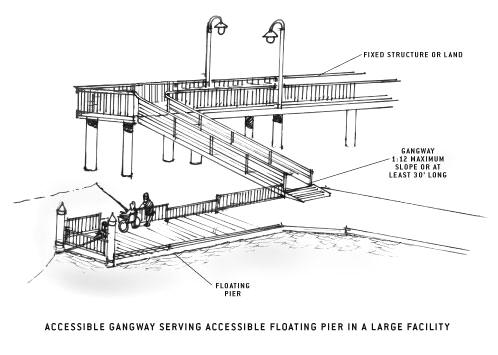Accessible Fishing Piers and Platforms - A Summary of Accessibility Guidelines for Recreation Facilities
Gangways
A gangway is a variable-sloped pedestrian walkway linking a fixed structure or land with a floating structure. Where gangways are provided as part of accessible routes to connect floating accessible fishing piers or platforms, the following exceptions to ADAAG have been included to deal with the varying water level changes and other factors in this dynamic environment. Designers and operators should note that there are no exceptions to the accessible route requirements where the accessible route connects to a fixed fishing pier or platform.
Gangway Slope and Rise Exceptions
Gangways must be designed to provide for a maximum 1:12 (8.33%) slope but are not required to be longer than 30 feet in length. There is no maximum slope requirement for gangways 30 feet or longer. For example, where the vertical distance between where the gangway departs the landside connection and the elevation of the pier surface at the lowest water level is 4 feet, the gangway would have to be at least 30 feet long. As water levels rise and fall, gangway slopes also rise and fall. At times, this gangway slope may be less than 1:20 (5%) and at other times it may be more than 1:12 (8.33%). Designers are encouraged to provide the least possible gangway slope, where possible, to give independent access to persons with disabilities.
The maximum rise requirements in ADAAG do not apply to gangways. As a result, no intermediate landings on the gangways are required and gangways may be any length.
The gangway slope and rise exceptions do not apply to other sloped walking surfaces that may be part of the accessible route. For example, where a non-gangway sloped walking surface greater than 1:20 (5%) is provided as part of an accessible route connecting accessible elements at a fishing facility, it must comply with ADAAG slope and rise requirements. This would include a ramp connecting a fixed pier or a float with fixed switchback ramps.
Gangway Alterations
Gangways on existing fishing facilities may be repaired or replaced without triggering the requirement to increase the gangway length. However, if the areas altered contain primary functions (such as a fishing station), existing gangways are considered part of the path of travel to the altered primary function areas and must be made accessible, if the cost to do so is not disproportionate. The Department of Justice has determined that it is not disproportionate to spend up to an additional 20 percent of the overall costs of alterations to the primary function area to make the path of travel accessible.
Transition Plates
Transition plates are sloping pedestrian walking surfaces located at the end of a gangway. Gangways are not required to have landings at the end, if transition plates are provided. If the slope of the transition plate is greater than 1:20 (5%), transition plates must have a landing at the end of the transition plate not connected to the gangway and comply with other ADAAG ramp requirements.
Handrail Extensions
ADAAG addresses handrail height, diameter, and extensions provided to the end of the gangway. Other specifications regarding vertical supports may be addressed in other building codes. Handrail extensions are not required where gangways and transition plates connect and both are provided with handrails. ADAAG does not require handrails on sloped surfaces that have a rise of less than 6 inches or a projection less than 72 inches, or a slope of 1:20 (5%) or less. If handrail extensions are provided, they do not need to be parallel with the ground or floor surface, since the surface may be moving due to water conditions.
Cross Slope
The cross slopes of gangways, transition plates and floating piers that are part of an accessible route must be designed and constructed not to exceed a maximum of 2 percent. Measurements, absent live loads, are to be made from a static condition (i.e., absence of movement that results from wind, waves, etc.). Where floating piers are grounded out due to low water conditions, slope requirements would not apply.
Elevators and Platform Lifts
In addition to regular elevators, limited use/limited application elevators or platform lifts that comply with ADAAG may be used instead of gangways as part of an accessible route connecting floating piers and platforms used for fishing.


User Comments/Questions
Add Comment/Question